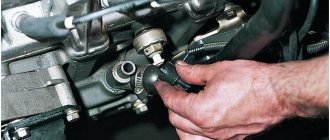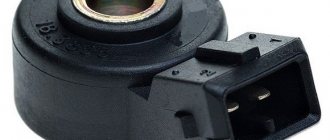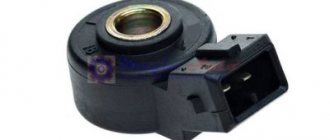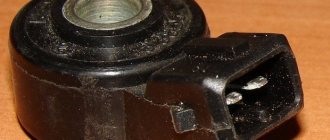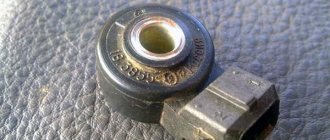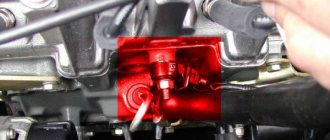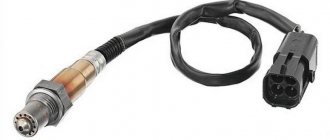With the advent of fuel injection systems, cars have become much more reliable and economical. To operate the injection system in the VAZ 2110, a huge number of different sensors are used to support and control all processes occurring in the internal combustion engine.
One of the main sensors in the VAZ 2110 is the knock sensor, which is what this article is about. Below we describe in detail the purpose of the sensor, its design, functions, symptoms of malfunction, testing and self-replacement.
Design and principle of operation of the knock sensor
There are two types of knock sensors - resonant and broadband. Resonant ones are currently considered obsolete (they are commonly called “old”) and are not used in new cars. They have one output contact and a barrel shape. The resonant knock sensor of the VAZ 2110 is configured to a certain sound frequency, which corresponds to micro-explosions in the engine (fuel detonation). However, this frequency is different for each engine, since it depends on its design, piston diameter, and so on.
A wideband knock sensor supplies the engine with information about sounds in the range from 6 Hz to 15 kHz (approximately, may vary for different sensors). And the ECU directly makes a decision about whether a particular sound is a micro-explosion or not. This sensor has two terminals and is most often installed on modern cars.
Two types of sensors
The basis of the design of a broadband knock sensor is a piezoelectric element, which converts the mechanical impact placed on it into an electric current with certain parameters (usually the changing current voltage supplied to the electronic engine control unit, ECU, is read). The design of the sensor also includes a so-called weighting agent, which is necessary to increase the mechanical impact.
The VAZ 2110 wideband knock sensor has two output contacts, to which, in fact, a variable voltage is supplied from the piezoelectric element. The value of this voltage is supplied to the ECU and, based on it, the control unit makes a decision about whether detonation is currently occurring or not. Under certain conditions, a sensor error may occur, which the ECU notifies the driver by activating the Check Engine warning light on the dashboard. There are two main methods for checking a knock sensor, and this can be done either by dismantling it or without removing the sensor from its installation location on the engine block.
A four-cylinder engine, as a rule, has one VAZ 2110 knock sensor, a six-cylinder engine has two, and eight- and twelve-cylinder engines have four. Therefore, when diagnosing, you need to carefully look at which knock sensor of the VAZ 2110 the scanner points to. Their numbers are indicated in the manual or technical literature for a specific engine.
Purpose of the knock sensor
The VAZ 2110 uses two types of knock sensors. Until 2003, a single-contact resonant DD was installed. Since 2002, the VAZ 2110 with an 8-valve and 16-valve engine began to use broadband knock sensors. The new and old type DDs are completely non-interchangeable, since they have different fastenings and operating principles.
The wideband knock sensor of the VAZ 2110 has the shape of a round torus. There is a hole in its center through which the fastening bolt is inserted. On the side of the DD there is a connector that serves to connect a circuit connecting it to the electronic control unit.
The resonant knock sensor does not require a bolt to secure it to the engine. Directly on its body there is a thread with which the meter can be screwed into the seat.
There is a sensitive element inside the DD housing. It reacts to vibrations. In the case of a resonant meter, monitoring is carried out in a narrow range. Vibrations are converted by meters into an electrical signal with a certain amplitude and frequency.
The electronic control unit constantly receives DD signals. The module controls and analyzes the amplitudes and frequencies of the incoming voltage. Deviation outside the nominal range indicates the occurrence of detonation. In this case, the ECU corrects the operation of the power unit according to the established algorithm.
Eliminating detonation minimizes parasitic destructive loads that affect the cylinder-piston group. Therefore, the main purpose of the DD can be considered to quickly determine the occurrence of vibration and detonation, which is the key to increasing the service life of the VAZ 2110 engine. This is what the knock sensor is responsible for.
Knock sensor VAZ 2110, main symptoms of malfunction
Before replacing the DD with a new one, it is recommended to check the electrical circuit of its connection. Also, very often, sensor failure is associated with oxidation of its contacts, in which case they should be cleaned. In general, the element is characterized by extremely high reliability and durability.
Problems with the sensor can be determined by conducting both computer diagnostics and drawing a conclusion based on the characteristic “symptoms” that appear when driving, namely:
- the car noticeably lost power;
- The “Check Engine” indicator lights up periodically: during acceleration, starting to move, or going uphill;
- the engine troits (runs with uncharacteristic sounds).
After reading the electronic fault codes of the internal combustion engine injector, you can draw the following conclusions regarding the state of your VAZ 2112 knock sensor:
- code 0325 hints at network problems. For example, a break in the wiring or acidification of the plug contacts. In this case, we call the electrical circuit connecting the sensor, clean the electrical contacts;
- If the above steps do not help, all that remains is to check the timing belt. its slippage may also be the cause of the problem;
- codes No. 0326, 0327, respectively, tell us about a poor signal level from the knock sensor of the VAZ 2112. Again we clean the contacts, check the tightening torque of the nut (from 10 to 24 N*m) or replace it with a new one;
- code 0328 indicates that the control signal from the knock sensor is too high. It is possible that the element is breaking, the wiring is faulty, or it is also necessary to check the engagement of the timing belt.
In this way, you can diagnose a malfunction on almost any VAZ 2110-2112 car of the injector type, except for the earliest models produced since 2002.
Diagnostics of the device knock sensor VAZ 2110
To be sure that the 2110/2112 knock sensor is faulty, it is worth checking it. This is done with a multimeter.
After all, you should understand that not in all cases the knock sensor will need to be replaced. In some cases, cleaning it will help. Sometimes other faults are detected that do not relate to the device itself. For example, an open circuit (network break). But in this case, the working connection diagram is subject to diagnosis.
If you don’t know how to check the device, then just follow the steps presented:
- Turn on the multimeter.
- Connect the wires to the two contacts of the broadband sensor. But there is a small note here: if we are talking about the resonant type, then the negative wire must be closed on the body, but the positive wire is in the center of the sensor.
- Take a screwdriver or any other metal object and start making small impacts on the sensor. But we’ll look at what this affects a little lower.
The thing is that, based on the force of the blows applied, the values on the measuring device will gradually change. They should fluctuate between 40–200 mV. This is the norm, which corresponds to the fact that the device is in good condition. But any serious damage to it will be reflected on the multimeter screen as a zero value.
Note that checking the knock sensor does not end there. Now you will need to identify the cause of the problem. Moreover, you need to look for it in the wires. In some cases, you may only need to replace the pad. The thing is that it is the one that is most exposed to the environment, which leads to corrosion on the contacts.
If you are interested in the question of how to diagnose an 8-valve injector, then you should note that in this case the process is more labor-intensive. The thing is that sometimes you need to spend extra time to remove it.
You will need:
- Dismantle the device.
- Set the multimeter to measure the applied voltage at about 200 mV.
- Place one probe on the connector of the device, and the second on the opposite connector.
- Start tapping with a screwdriver, as you did in the previous case. But focus your attention on the force of the blow, since the stronger it is, the higher the signal level should be.
- Finally, check the resistance of the piezoelectric element.
In general, the VAZ 2110 8-valve injector sensor breaks down extremely rarely. The most common reason for the absence of a signal on the ECU is a break in the connection circuit.
If this device is seriously damaged, you should consider purchasing a new one. But you definitely need to familiarize yourself with how to replace the knock sensor, because installing it incorrectly can lead to the problem not being resolved.
Knock sensor VAZ 2110 - malfunctions during operation
To identify malfunctions in the knock sensor, you need to know where it is located in the power compartment of the car. Its location is not far from the oil dipstick at the top of the cylinder block.
Sometimes the defect can be eliminated by simply tightening or loosening the fastening of the product to the motor; the tightening force should be within 20 Nm. It is better to control the tightening force of this type with a special torque wrench. If the adjustment does not have a positive effect, it is necessary to check the VAZ 2110 knock sensor and then replace it with a new product.
The search for faults in the knock sensor must be carried out on a special stand, which is equipped at service stations or repair plants. At home, you can try to repair the VAZ 2110 knock sensor if you have basic concepts in electrical engineering and the car enthusiast can use a tester or similar device with millivoltmeter and megohmmeter scales.
The procedure for determining a malfunction of the knock sensor is as follows:
- Before checking the knock sensor, it must be removed from the power unit. To do this, you need to press the latch and disconnect it from the contact block.
- Unscrew the fastening nut and dismantle the product by removing it from the stud.
- To diagnose a removed device, you need to power it to the terminals of the multivoltmeter, setting the minimum measurement limit.
Important: you should know that for a knock sensor with one contact, the black wire, which is associated with the negative contact, is connected to the socket of the mounting bolt, and the positive red wire must be connected to the signal contact in the shoe connector.
What are the symptoms of a broken knock sensor?
Separated from the entire system, the controller itself is reliable and rarely subject to mechanical damage. Its work is influenced by a number of indirect factors.
A decrease in its functionality may be suspected in the following cases:
- engine slowdown;
- increasing speed at minimum speeds;
- when the car has problems accelerating;
- if fuel consumption has increased compared to normal levels;
- with uncharacteristic engine knocking and spontaneous jerks (engine trouble).
Code indicator 34 is a signal of DD failure. The on-board computer sometimes makes mistakes; you can check the validity of its readings like this. To confirm, reset the self-diagnosis, drive several kilometers, and if the error readings disappear, it means the sensor terminals are loose or oxidized while driving.
Error 325 indicates a break in the knock sensor of the VAZ 2120, sometimes under this sensor fault code, the ECU stores the location of the throttle valve. To verify this, find in the menu the voltage value in the sensor of interest; if there is a problem with the damper sensor, the indicator in the menu will jump, but for the DD it will remain static.
Why does the VAZ 2110 knock sensor fail?
This happens for several reasons:
- Due to a broken signal wire.
- Due to the sensor shorting to ground.
- When the shielding braid of the wire breaks.
- When the on-board network of one of the wires is short-circuited (however, this problem occurs quite rarely).
But whatever the reason, only diagnostics will help determine the functionality of the element. We will tell you how to do this yourself below.
Detonation catalysts
All engines are susceptible to detonation, to a small or greater extent. It is necessary to know the factors influencing the increase in detonation and try to neutralize them. These include:
- Low detonation resistance of fuel;
- Design and functional features of the internal combustion engine and the nature of its relationship to other elements of the car. These factors include: the degree of piston compression of the mixture, the design features of the chamber itself, the distance from the spark plugs, and many other circumstances;
- Violations of the proportions in mixing the components of the mixture;
- Incorrect ignition parameters (advance angle and mixture supply timing);
- Excessive load at low speeds;
- Strong heating of engine elements and ignition from carbon deposits, which is a consequence of incorrect operation of the cooling system.
Signs of a malfunction knock sensor VAZ 2110
Before replacing the knock sensor, make sure that it is not working. Most often, sensor failure is due to an open circuit. This is expressed primarily in engine overheating and loss of power. In addition, the Check Engine warning light may come on when the load on the engine increases , the engine may stall and operate unstably regardless of speed.
When the knock sensor fails, the Check Engine light comes on.
Types of knock sensor VAZ 2110
There are two types of knock sensors:
- resonant type;
- broadband sensor.
The first type of sensor is configured to oscillate at a certain frequency, it is more accurate and is used on cars manufactured after 2002–2003 . A wideband sensor perceives the entire spectrum of frequencies and its readings are approximate, and the range of the transmitted signal is quite wide.
The two types of sensors are not interchangeable, and before checking and installing a new one, you must know exactly what type of sensor is installed on the engine.
The knock sensor on the VAZ-2112 is located on the front of the engine, next to the oil dipstick.
The sensor is screwed into the cylinder block on the left side under the spark plugs; its replacement and diagnostics take a few minutes.
Kinds
Broadband
For the VAZ 2110, the use of two types of knock sensors is provided.
- Broadband. They regularly monitor the noise spectrum and report them to the engine control system. The corresponding signal is processed, the engine adjusts its operation.
- Resonant. They perform similar functions to broadband ones, however they only produce signals when the detonation changes.
Small differences between devices do not in any way affect their reliability, service life or efficiency. Therefore, failure of such a regulator is an extremely rare occurrence. But sometimes it happens. Most likely, the cause of the malfunction is the presence of an open circuit . First of all, it is checked. Most often, after the gap is repaired, the sensor returns to normal operation.
Methods for checking the knock sensor VAZ 2110
If there are signs of a malfunction of the knock sensor, then first of all you need to check the error log in the on-board computer. About DD malfunction they say:
- code 0325, indicates an open circuit in the sensor circuit;
- code 0326 or 0327, reports low signal level;
- code 0328, the amplitude of the voltage coming from the sensor is too high.
You can indirectly check the DD by checking the resistance with a multimeter. For a working sensor it ranges from 1 to 10 MOhm.
You should also check the voltage with a multimeter. To do this, the probes are connected to the contacts, and light blows are applied to the working surface of the DD with a bolt or rod. If there are no voltage surges, the sensor needs to be replaced.
Measurements of the knock sensor VAZ 2110
Now you can check with a multimeter set to the minimum value. If the sensor is single-contact, then the negative wire of the multimeter (it is usually black) is connected to the place where the mounting bolt is installed, and the positive wire (usually red) is connected to the signal contact in the connector.
Checking the two-contact sensor is carried out by connecting the multimeter wire to the corresponding contact “-” to “-”, “+” to “+”. Further actions are identical. To activate the sensor, you need to tap it with something not very hard (for example, a screwdriver).
If there are no faults, voltage surges will be observed. Approximately 40 to 200 mV. In addition, it would not hurt to check the internal resistance, which should tend to zero. If you find that the sensor is fine, then look for an open circuit. In this case, the best advice is to replace the entire block with wires.
If the resistance is different, or there are no voltage surges, it means that there is something wrong with the sensor itself and it needs to be replaced. The new one is installed in the reverse order of removal.
Checking the serviceability, maintenance and replacement procedure for the VAZ 2110 knock sensor
The principle of operation of a device such as a knock sensor is similar on all modern vehicles. This device is quite reliable and consists of a homogeneous monolith with an integrated special plate with a piezoelectric element, which responds to shock at the desired frequency. It is this wave action with a certain frequency that is formed in the cylinder block of a power plant during combustion of the air-fuel mixture.
The electrical current with a voltage of several millivolts, which appears as a result of this influence, serves as the source of measurements that are fed to the car's on-board computer. And the electronic system of the vehicle adjusts the ignition timing, neutralizing with these actions possible shock effects that occur during fuel detonation.
Despite the fact that the VAZ 2110 knock sensor, the price of which is quite reasonable, has small linear dimensions and is very simple in design, its importance can hardly be overestimated. After all, the loss of the switching signal from this product leads to the display of the corresponding failure code on the display of the on-board computer, which is deciphered in the VAZ 2110 as a knock sensor error and leads to the transfer of the ECU to a safe operating mode.
This, in turn, optimizes the software costs of the electronic control unit, adjusts the ignition timing to a minimum value, which leads to an increase in fuel consumption and a decrease in the dynamic power of the car.
If the knock sensor breaks, the vehicle is operated for a certain period of time without this setting. The same applies to the case when faults are identified in the knock sensor, but it is not possible to replace it. In any case, there is no point in delaying repairs or replacement of this device.
Replacing the device
It should be clear that the connection of a new detonation device VAZ 2110 8 valves or 2112 16 valves is carried out after dismantling the old one. This process will not take much time. The only thing to keep in mind is that you will need a torque wrench.
Installation sequence:
- Turn off the ignition if necessary.
- Remove the wiring block.
- Unscrew and remove the old device. It is unscrewed with different keys depending on the type of device itself. For broadband you will need the thirteenth key, and for resonant - the twenty-second.
- Install a new device.
- Start tightening the nut from 10 to 23 Nm.
If you did everything correctly, your engine will operate stably, and the ECU will receive signals in a timely manner.
Remember that only when you have checked the device with a multimeter and you can completely verify that it is faulty can you replace it. This will allow you to save not only money, but also the time that you will have to spend on replacing and installing a new device.
Location of the knock sensor on the VAZ 2110
The location of the knock sensor was chosen to obtain the greatest sensitivity. To do this, it is installed directly on the power unit between the second and third cylinders. The oil dipstick can serve as a guide for determining the installation location. Also in close proximity is the air filter housing.
Removal
1. We prepare the car for work (see paragraphs 1 and 2 “Preparing the car for maintenance and repair”).
2. Using a 13 mm socket wrench, unscrew the bolt securing the knock sensor to the cylinder block.
3. Remove the sensor from under the intake module.
4. By pressing the latch, disconnect the wiring harness connector from the sensor.
How to change the sensor?
If this element fails, it must be replaced. Fortunately, spare parts for the VAZ-2110 can be found in any store for a low price. A new knock sensor will cost no more than 250 rubles. How to replace it? First you need to find the element itself. As we said earlier, it is located between the second and third cylinder.
Then, using a 12 mm wrench, unscrew the mounting bolt. Next, you need to press on the plug of the wire clamp and pull it out. Afterwards you can remove the sensor itself. At the next stage, a new spare part is installed on the VAZ-2110. Having installed the plug with the wires, you should screw back the mounting bolt with a 12mm wrench. At this stage, replacing the knock sensor on the “ten” can be considered complete.
Dismantling the knock sensor VAZ 2110
First you need to find the sensor. It is located on the left side of the engine, where the line is half of the cylinder block. Next to it is the air filter.
To determine the malfunction or its absence, it is necessary to remove it in the following sequence:
- Disconnect the car from power by removing the negative terminal from the battery;
- Disconnect the block with wires from the contacts of the knock sensor. To do this, press the latch;
- Unscrew the nut securing the device and remove it from the mounting stud.
Please note that during further installation or replacement you will need a torque wrench (tightening force should be 20 Nm).
Replacing the knock sensor
Frequency of work to replace the tens knock sensor:
- Disconnect the negative power cable from the battery.
- Disconnects the product wiring from the wiring block.
- We remove the fasteners of the product and dismantle it.
- To activate the knock sensor, you need to knock on the body of the product.
- If the device is in working order, the product will show jump-like values of the potential difference within the limits of 40 to 200 mV.
If necessary, it is possible to measure the resistance of the internal circuit of the part. It is important to remember that this value for devices of this type is very large, tending to infinity.
If at least one indicator (resistance or voltage) is missing, you need to buy a new product and prepare to replace the VAZ 2110 knock sensor, since there are no other ways to resuscitate it.
Self-replacement of sensor 21120385501001 on a VAZ 2110
Replacement of the resonance sensor is carried out according to the instructions below
- Disconnect the connector.
- Unscrew the sensor.
- Remove the sensor.
- Install a new sensor, tightening to a torque of 20 Nm.
- Connect the connector.
Varieties
If we talk about the types of VAZ phase sensors, then in domestic “tens” the following types of regulators can be used:
- broadband controller;
- resonant type device.
In wideband versions, the ADC converter perceives the impact of all current pulses that the device generates. If resonance suddenly appears in the system, then the measuring unit can only perceive vibrations at one frequency or another, which is relevant for the moment of detonation in the engine.
It should be noted that both types themselves are not interchangeable, since their pulse levels differ significantly. So if you are faced with a problem with the operation of the device and, accordingly, with the need to replace the knock sensor, then it is better to install the same regulator that was already installed (the author of the video is the Engine Repair channel! And interesting!).
How to check a newly purchased VAZ 2112 knock sensor or the condition of an old one
Despite the low cost of the product, there are often cases of purchase when you receive a low-quality VAZ 2112 knock sensor or just a dummy disguised as one. Therefore, it will be useful to understand exactly how to check and diagnose a sensor removed from a car or purchase a new one.
To check, you will need an electrical multimeter. set to a measurement range of 200 mV DC voltage. Connect the probes of the device to the connectors of the broadband sensor to measure electrical quantities (in the case of a resonant one, one probe measures relative to the body).
Tap the sensor body with a screwdriver. The absolute voltage values recorded by the device will directly depend on the degree of physical impact on it: the stronger the impact, the higher the voltage pulse. If the dependence can be traced, then the DD is working.
Now we switch our multimeter to measuring resistance. The measured ohmic load in a working sensor should be in the range from 1 to 10 MOhm. Naturally, a faulty DD or its dummy will show infinite resistance, and a broken one will show very small resistance, on the order of a few tenths of an ohm.
List of errors associated with DD from the on-board computer
The cause of the failure can be found out by analyzing the error signal on the console:
- 0325 indicates a break in the DD circuit, which can be eliminated by cleaning the sensor connectors from oxidation and ringing the wiring;
- 0325 may also indicate that the timing belt is shifted by one tooth; it is necessary to check that the belt is installed correctly;
- 0326, 0327 indicates a low controller signal, requires checking the connectors, securing the nut with a force of 10-23 Nm, the action is performed with a special torque wrench.
- 0328 - the control signal is higher than normal, may appear when the electrical circuit is broken, a piercing element, or a faulty DD.
Sensor cost
The sensor has extremely low maintainability, so if it fails, it must be replaced with a new sensor. On cars with engines with 8 and 16 valves, sensor 21123855020, manufactured by Lada, is installed. Its price is 180-400 rubles. If it is impossible to purchase the original, you should buy any of the analogues presented in the table below.
Table - Good analogues of the original Lada Priora knock sensor
| Manufacturer | vendor code | Approximate cost, ruble |
| Decaro | 2112-3855020 | 360-490 |
| Road map | 21123855020 | 260-380 |
| Samara 2112 | 3855020 | 200-250 |
| Fenox | SD10100O7 | 210-420 |
| ERA | 550489 | 300-340 |
Final result
Finally, a few words about installing the sensor after checking it. Remember that the metal surface of the sensor must be clean and free of debris and/or rust. Clean this surface before installation. Similarly with the surface on the sensor seat on the engine housing. You also need to perform preventative cleaning. The sensor contacts can also be lubricated with WD-40 or its equivalent for preventive purposes. And instead of the traditional bolt with which the sensor is attached to the engine block, it is better to use a more reliable pin. It secures the sensor more tightly, does not loosen the fastening and does not unwind over time under the influence of vibration.
